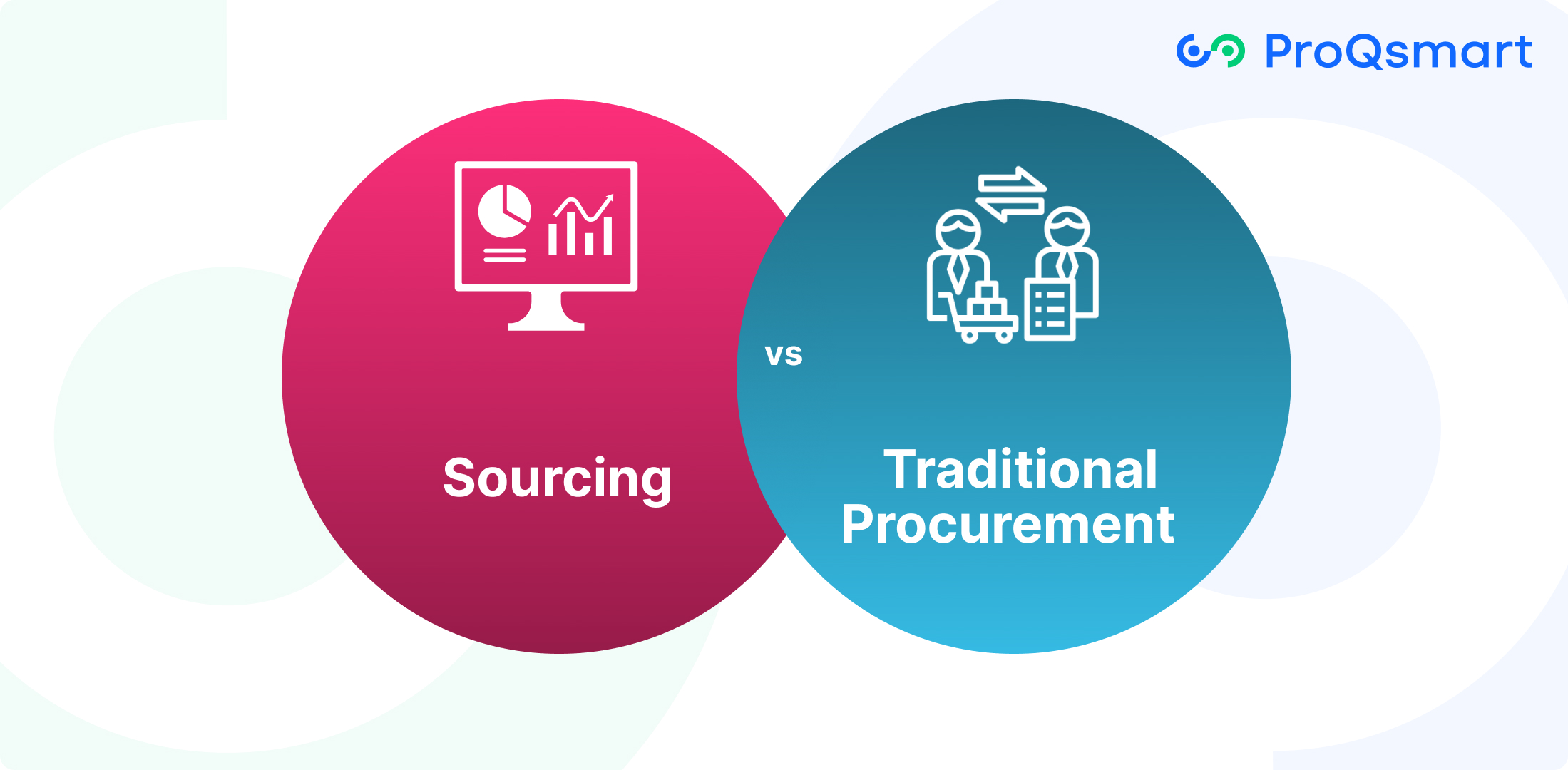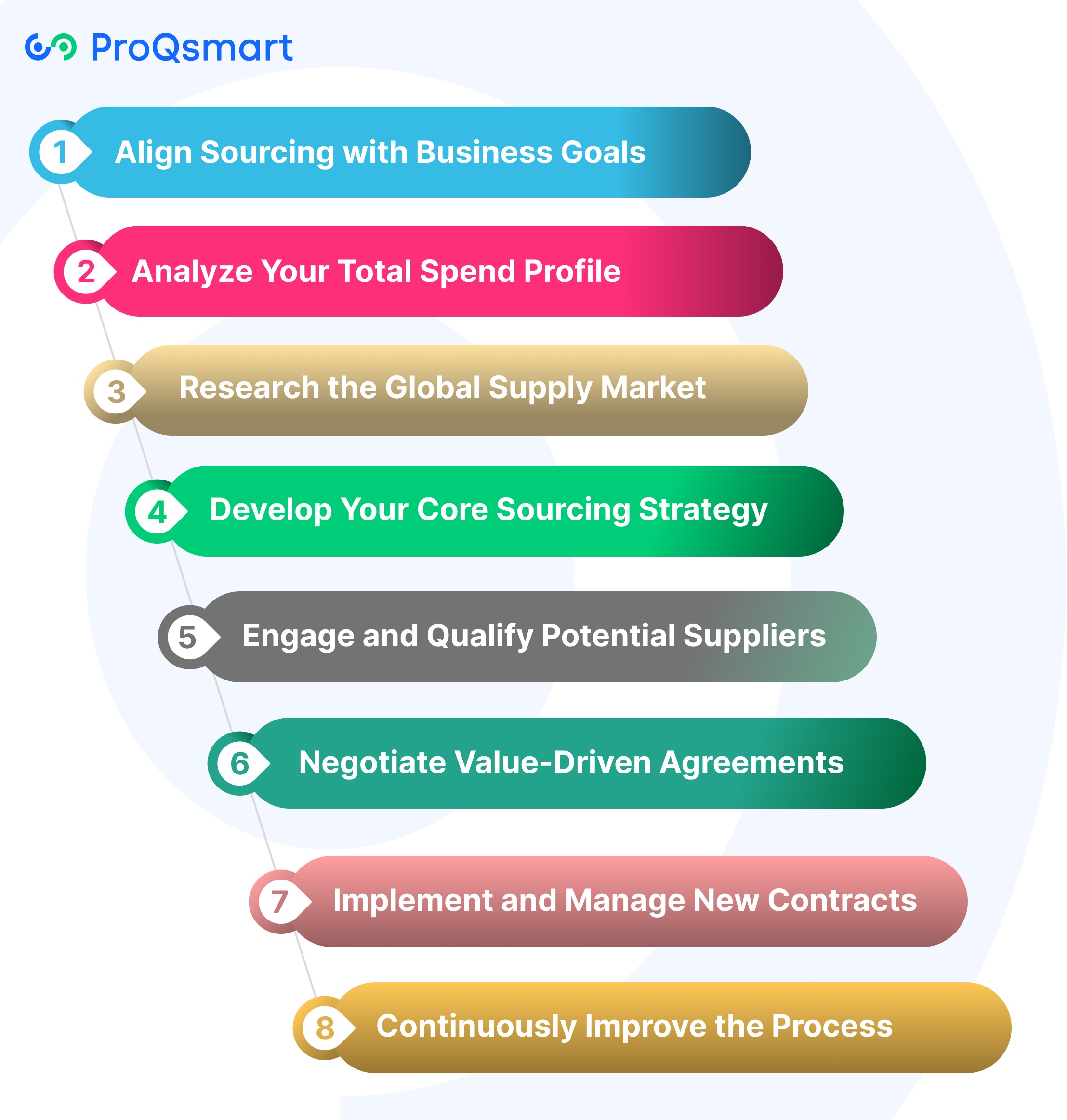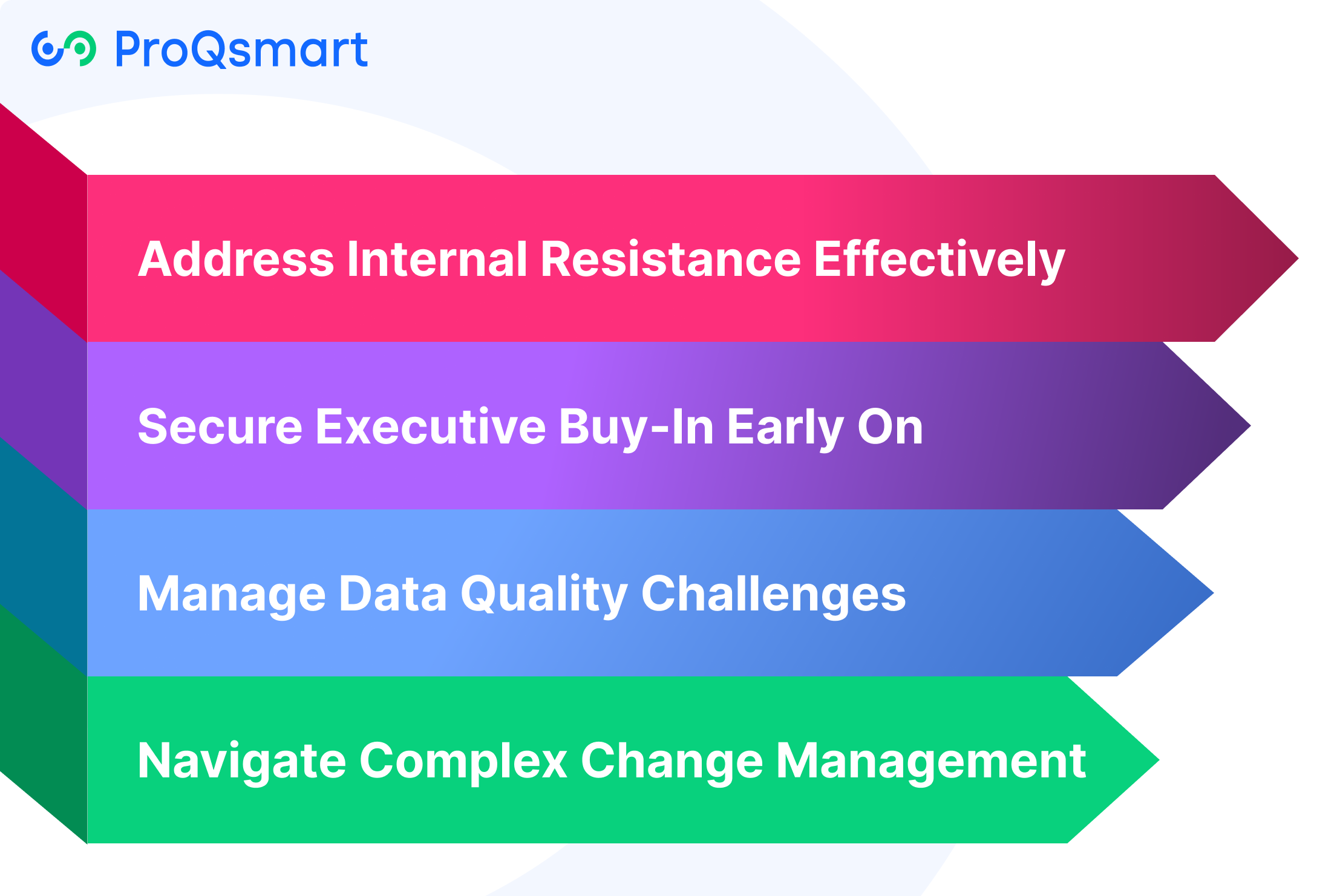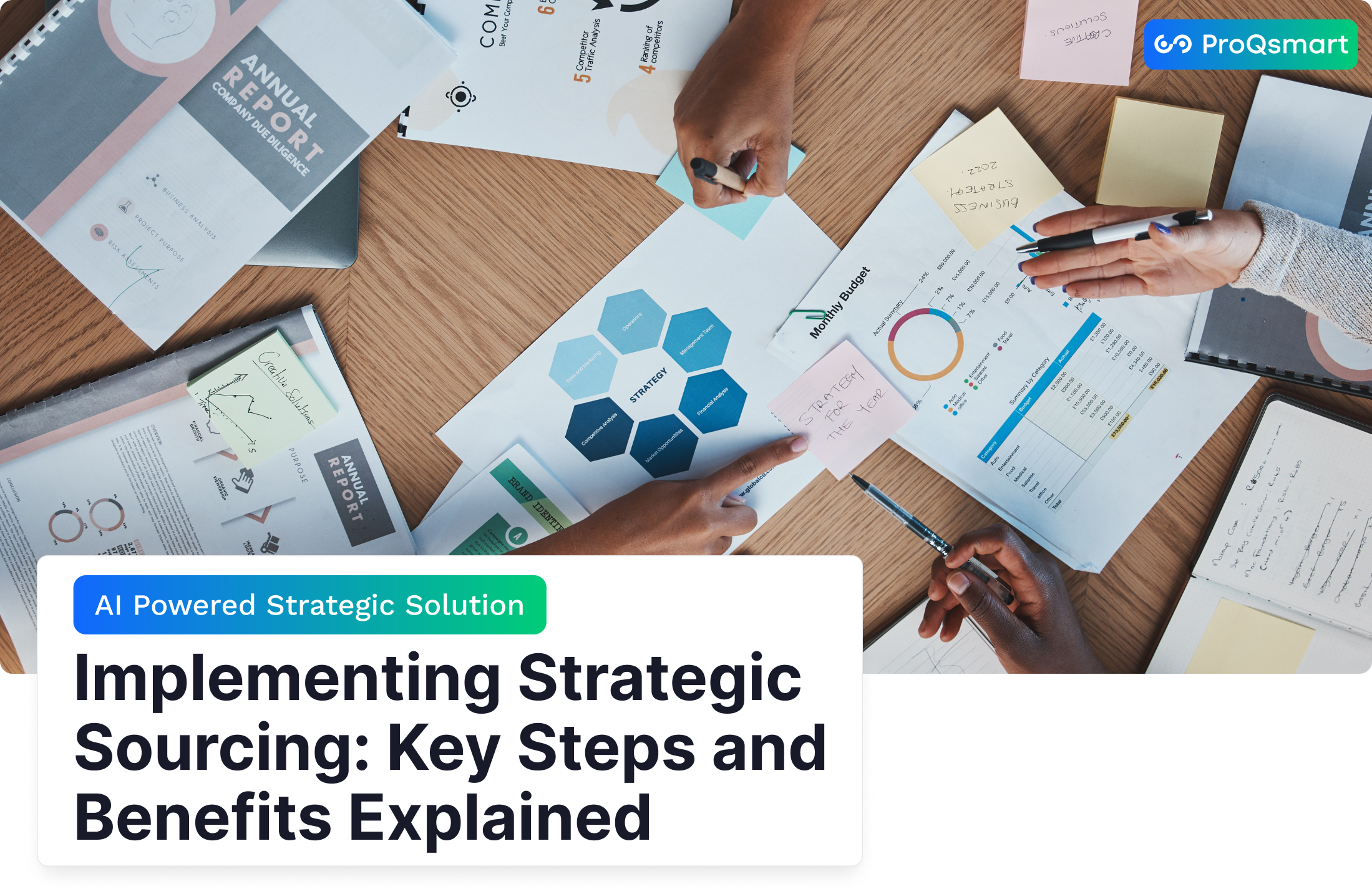Implementing strategic sourcing is the best way for businesses to streamline their procurement processes, lower costs, and cultivate better relationships with suppliers. An emphasis on long-term value encourages organizations to pursue deeper, more innovative sourcing solutions.
This strategy connects those decisions with their larger business objectives. Quality, cost or sustainability—all these supplier evaluation criteria and more become strategic sourcing capabilities used to make better decisions that proactively drive operational performance.
For manufacturers, it takes the guesswork out of navigating a complex global supply chain and provides for reliable delivery of materials or components. Data-driven insights continue to sharpen the process, pinpointing greater opportunities for improvements and minimizing risk.
Sourcing vs. Traditional Procurement

Strategic sourcing and traditional procurement serve distinct roles within supply chain management, each defined by its scope, objectives, and approach. Traditional procurement tends to emphasize short-term criteria such as lowest price, quality, and reliability.
Strategic sourcing differs in that it takes a broad, long-term approach. It proactively aligns supplier relationships with broader organizational goals, thus meeting both present and anticipated business needs.
Focus on Collaboration and Partnerships
Strategic sourcing promotes collaboration over the transactional relationships fostered through traditional procurement. By building collaborative relationships with suppliers, companies can cultivate win-win scenarios that go beyond transactional interactions.
Here, open communication and transparency are key, establishing a foundation to promote shared goals between a company’s objectives and a supplier’s strengths and capabilities. A manufacturing company may be able to work especially tightly with a materials provider.
Collaboratively, they can identify sustainable approaches that will increase production efficiency while minimizing waste. This is a far cry from traditional procurement, where communication often stops at purchase order issuance and pricing discussions.
Adopting a Long-Term Strategic View
Strategic sourcing matches the goals of an organization’s overall strategic plan, focusing on sustainability and long-term value. This method continuously tests suppliers against upcoming requirements.
It holds partnerships accountable to develop as the business scales, in contrast to the ad hoc, reactive approach of traditional procurement. A technology company, for instance, might prioritize suppliers that provide exciting new renewable materials.
This strategy allows them to make good on their commitments to shareholders and the planet.
Objectives Beyond Simple Cost Cutting
Cost reduction is only one facet of strategic sourcing. It focuses on quality improvement goals, risk management, and has an eye toward supplier performance.
For instance, unlocking supplier innovation could lead to superior designs or more efficient logistics, providing multiplied benefits over years.
Emphasis on Data-Driven Decisions
Strategic sourcing drives every decision by data and analytics—from evaluating and bidding suppliers to negotiating contracts. These data insights allow for better, more informed choices to ensure program outcomes such as cost efficiency and long-term supply chain resilience.
Traditional procurement is rarely this prescriptive and prescient, typically settling for the transactional in the moments that matter.
Why Adopt Strategic Sourcing?
Strategic sourcing is much more than just a procurement strategy. It requires a holistic approach to truly optimize costs, find efficiencies that improve supplier relationships and deliver greater business value. By establishing both short and long-term goals, organizations can strategically align their procurement function with their overarching business objectives.
This approach creates innovation and strengthens resilience in the corporate metagame.
Achieve Significant, Sustainable Savings
Strategic sourcing cuts deeper to more fundamentally identify cost-saving opportunities that are not merely elaborated price comparisons. By analyzing spending patterns and leveraging data analytics, businesses can uncover inefficiencies and implement targeted measures to lower their Total Cost of Ownership (TCO).
For instance, doing things like consolidating purchases across departments or using the increased volume you negotiated with suppliers to re-negotiate existing contracts can save 10-15%. This becomes even easier with ProQsmart’s robust budget-driven procurement tools that help align sourcing decisions with real-time financial tracking.
Reduce Supply Chain Vulnerability
A robust supplier risk assessment is central to strategic sourcing. Diversifying the supplier base safeguards against disruptions, such as raw material shortages or geopolitical shifts.
Tools like ProQsmart’s vendor management system automate risk evaluation, enhancing supply chain resilience and ensuring continuity during market fluctuations.
Accelerate Your Time-to-Market
With more efficient sourcing processes, companies can launch products in record time. By leveraging collaborative frameworks with their suppliers, organizations can accelerate delivery schedules.
ProQsmart’s e-tendering system makes it easy for vendors to find the right documentation and submit their bids on time.
Gain Clear Supplier Performance Insights
Supplier performance supports informed sourcing decisions by using KPIs to track supplier reliability and quality. ProQsmart’s strategic sourcing solutions deliver actionable insights, empowering ongoing improvement.
Foster Stronger, Collaborative Partnerships
Open and transparent communications improve trust and loyalty, which stimulate suppliers to proactively provide invaluable feedback.
Further, ProQsmart’s collaborative features promote agreement and shared understanding, making it a win-win for both sides.
Drive Innovation Through Suppliers
Strategic sourcing solutions encourage innovation by fostering a greater appreciation for supplier input. ProQsmart promotes a culture of collaboration where the strategic sourcing team integrates the supplier’s smart ideas into the formula for success.
Implement Strategic Sourcing Step-by-Step

Strategic sourcing is a data-driven, collaborative process that enhances supplier collaboration while improving the quality, speed, and cost of procurement. By aligning strategic sourcing processes with overall business goals, procurement professionals can ensure sustainable and effective sourcing practices.
1. Align Sourcing with Business Goals
Thus, sourcing strategies should clearly and directly advance organizational objectives such as cost efficiency, innovation, sustainability, etc. Setting and clearly communicating these priorities to procurement teams helps align all stakeholders to pursue common goals.
If sustainability is a key goal, then renewable materials or ethically sourced items should be prioritized in sourcing.
2. Analyze Your Total Spend Profile
A thorough spend analysis will help you spot purchasing trends, reliance on certain suppliers, and where you can save the most money. For example, providing guidance to consolidate purchases across departments can cut unnecessary duplications and get departments better bulk pricing.
Knowing who spends what and where is the bedrock on which effective decision-making lies.
3. Research the Global Supply Market
Researching market trends identifies trends such as price changes or new supplier entry. Determining suppliers by their capability, reliability, and scalability involves making sure that their business needs are in sync.
For example, a supplier with strong logistics capabilities can help your team shorten lead times.
4. Develop Your Core Sourcing Strategy
A customized approach better meets agency priorities and business objectives, and reduces risk.
Including compliance from the start helps you stay within regulatory bounds. For instance, focusing on robust, dependable suppliers helps minimize interruptions from outside events like a pandemic.
5. Engage and Qualify Potential Suppliers
Establish high standards of evaluation, including quality thresholds and financial viability, as part of the strategic sourcing process. Detailed evaluations, even to the level of site visits, help validate that potential suppliers are living up to the claims.
6. Negotiate Value-Driven Agreements
Negotiate to create long-term value—not just to drive down the cost. Effective sourcing strategies can help companies save on average 15% per year.
7. Implement and Manage New Contracts
Establish effective supplier management standards and regularly review vendor performance to enhance strategic sourcing processes and improve operational performance.
8. Continuously Improve the Process
Ensure ongoing accountability by reviewing the strategic sourcing processes in real time and incorporating stakeholder experience to continuously improve strategies.
Leverage Technology for Sourcing
Technology is changing the nature of strategic sourcing now more than ever. It enhances operational efficiencies, hones strategic decision-making, and yields substantial budgetary savings. When procurement teams embrace advanced tools and automation, they can optimize their workflows, reduce redundancies and reallocate resources towards higher-value tasks.
Here’s a closer look at how technology reshapes and refines the sourcing process.
Utilize Modern Procurement Software
Implementing procurement software is the key to leveraging technology for sourcing. Technology Solutions Platforms like ProQsmart’s Sourcing Management help streamline complex sourcing activities. ProQsmart’s solution automates sourcing events, supplier identification, and vetting while offering advanced analytics to uncover cost-saving opportunities and manage risks. NetSuite offers advanced supplier vetting, integration with ERP software, and real-time financial and operational reporting.
Seamless integration with current processes and systems ensures these tools can work harmoniously within infrastructures already in place. Our ProQsmart platform further amplifies this by automating workflows, offering e-tendering for simplified bidding, and ensuring compliance with accurate sourcing data.
Employ Advanced Analytics Tools
Together, these analytics tools and technology allow teams to better harness their data, empowering them to make data-driven decisions. Secondly, Ivalua’s centralized supplier repository acts as a single source of truth, breaking down data silos and enabling a holistic view of supplier management.
Programs such as NetSuite take into account the total cost of suppliers and identify where the most value is produced. Data visualization techniques, like dashboards, make it easy to understand findings for stakeholders, delivering clear takeaways that can lead to action.
ProQsmart strengthens this ability through tracking supplier performance and matching procurement decisions to budgetary priorities.
Automate Repetitive Sourcing Tasks
Automation increases productivity by removing the potential for human error and allowing time and capital to be focused elsewhere. Strategic sourcing software can streamline tedious processes, such as maintaining supplier pre-qualification and document databases.
ProQsmart lowers the cost of subcontractor management, bill of quantities management and helps integrate capital expenditure sourcing so teams can think strategically.
Strategic Sourcing Best Practices
Strategic sourcing reinvents procurement by refocusing it on the greater business purpose. It reduces total cost of ownership (TCO) and improves collaboration with suppliers. By implementing best practices, organizations can improve productivity and reduce disruptions and risks across the supply chain.
Here are five best practices to ensure strategic sourcing efforts make the biggest difference.
Integrate Supplier Relationship Management
Having a clear and consistent playbook in place to vet and manage supplier relationships is important. Setting up touchpoints with vendors ultimately improves transparency and trust, making it easier to maintain mutually beneficial partnerships.
By involving suppliers early and often, companies can proactively respond to new challenges together, fostering a culture of innovation and improvement. For instance, by leveraging ProQsmart, organizations can improve real-time collaboration and proactive supplier performance monitoring to keep the most mutual and beneficial relationships strong.
Look Past the Initial Price Tag
Approaching supplier evaluation based only on upfront expenditures can sabotage ongoing value. Rather, organizations need to look at the total cost of ownership (TCO), including quality, reliability, and lifecycle costs.
Aligning vendor selection with these focused, pragmatic metrics gives businesses a pathway to sustainable value. Selecting a supplier who might have marginally higher initial costs will save you money over time. Better durability will lead to fewer interruptions and maintenance costs down the line.
Define Clear Success Metrics (KPIs)
Without shying away from KPIs, measurable key performance indicators are key to measuring the success of your sourcing. Metrics such as cost savings, supplier performance, and delivery timelines help you take informed actions.
By consistently measuring these KPIs, you can stay focused on achieving your program’s objectives and spot opportunities for improvement.
Foster Cross-Functional Teamwork
Bringing together procurement professionals, finance, and operations teams to address these needs allows for the greatest range of perspectives to be considered. Cross-functional strategic sourcing teams streamline decision-making, ensuring sourcing aligns with overall business goals.
Measure ROI and Business Impact
Establishing ROI from sourcing decisions in quantitative terms showcases their worth to stakeholders. Additionally, tools like ProQsmart provide strategic sourcing solutions that deliver data-driven insights, helping procurement professionals align their strategic sourcing processes with bottom-line results.
Overcome Sourcing Implementation Hurdles

Strategic sourcing implementation is crucial for fueling efficiency and long-term growth. However, as most organizations encounter significant challenges, nearly 4 out of 5 report roadblocks hindering progress. Overcoming these barriers necessitates a thoughtful strategic sourcing process, enabling procurement professionals to facilitate effective implementation and achieve quantifiable outcomes aligned with overall business goals.
Address Internal Resistance Effectively
In our experience, internal resistance usually originates from the absence of an educational component to explain the advantages of a strategic sourcing approach. By articulating benefits like reduced spending, increased efficiency, and stronger supplier connections, you’ll help get stakeholders on board.
Engaging relevant stakeholders from the start helps to identify and incorporate their concerns, building goodwill, collaboration, and alignment. For instance, using solutions such as supplier portals to keep suppliers informed with real-time information fosters trust and improves transparency.
Secure Executive Buy-In Early On
Therefore, overcoming implementation hurdles means presenting a compelling business case to leadership. Draw connections between sourcing initiatives and org goals, like being on budget or doing better with compliance.
Platforms such as ProQsmart, including budget-driven procurement and supplier performance monitoring, offer data-backed insights that further bolster your case. Showing alignment is the best way to engender support at the executive level.
Manage Data Quality Challenges
Accurate and timely data serves as the foundation of all winning sourcing strategies. Setting clear standards and protocols for data entry and consistency and performing routine audits can eliminate accidental errors.
By leveraging AI-backed tools, like ProQsmart’s automated workflows, you get rid of these inefficiencies and make better, faster decisions.
Navigate Complex Change Management
Making the transition to strategic sourcing involves more than just new processes, so you’ll need a comprehensive change management plan. Providing ample training and helpful resources reduces implementation disruption and thoroughly prepares stakeholders to adjust to the changes.
Conclusion
Strategic sourcing is not just a technical process, it’s an entirely new paradigm in how you buy. It improves supplier relationships, lowers costs, and creates long-term value. By following a simple process and leveraging the right technology, you can demystify strategic sourcing and procure more strategically. It’s no longer just about trimming costs—it’s about creating a more efficient, innovative and flexible supply chain.
Implementing strategic sourcing may require a bit more legwork upfront, but the outcome is clear and compelling—just ask Wisconsin! You get more control, greater efficiency, and respond to market demands in a more agile, immediate way. The right strategies help you maintain sustained operations, even during uncertain times.
Want to learn more about making the leap? Learn more about ProQsmart and schedule a demo today!




